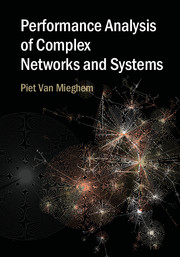Book contents
- Frontmatter
- Dedication
- Contents
- Preface
- Symbols
- 1 Introduction
- Part I Probability theory
- Part II Stochastic processes
- Part III Network science
- 15 General characteristics of graphs
- 16 The shortest pat problem
- 17 Epidemics in networks
- 18 The efficiency of multicast
- 19 The hopcount and weight to an anycast group
- Appendix A A summary of matrix theory
- Appendix B Solutions of problems
- References
- Index
19 - The hopcount and weight to an anycast group
from Part III - Network science
Published online by Cambridge University Press: 05 June 2014
- Frontmatter
- Dedication
- Contents
- Preface
- Symbols
- 1 Introduction
- Part I Probability theory
- Part II Stochastic processes
- Part III Network science
- 15 General characteristics of graphs
- 16 The shortest pat problem
- 17 Epidemics in networks
- 18 The efficiency of multicast
- 19 The hopcount and weight to an anycast group
- Appendix A A summary of matrix theory
- Appendix B Solutions of problems
- References
- Index
Summary
In this chapter, the probability density function of the hopcount and of the weight of the shortest path to the most nearby member of an anycast group consisting of m members (e.g. servers or peers) in a graph of N nodes is analyzed.
The results are applied to compute a performance measure η of the efficiency of anycast over unicast and to the server placement problem. The server placement problem asks for the number of (replicated) servers m needed such that any user in the network is not more than j hops away from a server of the anycast group with a certain prescribed probability. As in Chapter 18 on multicast, two types of shortest path trees are investigated: the regular k-ary tree and the irregular uniform recursive tree treated in Chapter 16. Since these two extreme cases of trees indicate that the performance measure η ≈ 1 — a log m, where the real number a depends on the details of the tree, it is believed that for trees in real networks (as the Internet) a same logarithmic law applies. An order calculus on exponentially growing trees further supplies evidence for the conjecture that η ≈ 1 — a log m for small m.
In peer-to-peer (P2P) networks (see e.g. Van Mieghem (2010a, Chapter 13)) such as Napster, Bit Torrent and Tribler, content is often either fully replicated at a peer or is split into chunks and stored over m peers. A major task of a member of the peer group lies in selecting the best peer among those m peers that possess the desired content.
- Type
- Chapter
- Information
- Performance Analysis of Complex Networks and Systems , pp. 517 - 538Publisher: Cambridge University PressPrint publication year: 2014



